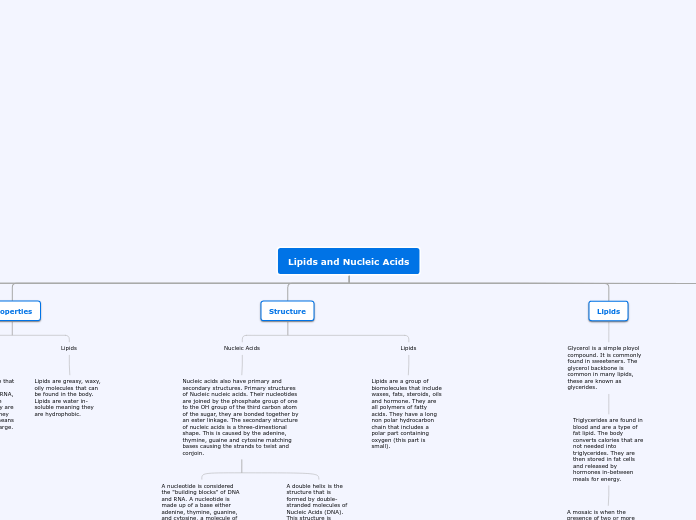Lipids and Nucleic Acids
Linkage
Lipids
Ester linkages are formed by dehydration synthesis between the hydroxy group in glycerol and the carboxyl group of fatty acids.
Fatty acids are carbolic acids with long aliphatic chains, there are either saturated or unsaturated.
Amphipathic is a molecule that has both polar and non-polar parts (hydrophilic and hydrophobic parts).
Phospholipids are a type of lipids that have amphipathic characteristics, which allows them to form lipid bilayers. The structure of phospholipids contain two fatty acid hydrophobic tails and a hydrophilic head, as well as containing a phosphate group.
Nucleic Acids
Phosphodiester bonds make up the backbone of nucleic acid strands.
Function
Lipids
The functions of lipids are they act as structural components of cell membranes, storing energy, and signaling.
Lipid bilayers are two layers of lipid molecules creating a thin polar membrane. The bilayer forms a barrier around the cells.
Glycolipids are a type of lipids with carbohydrates attached by glycosidic bonds. The function is to maintain the stability of the cell membrane and to function cellular recognition. This is important during the connection of cells, which forms cell tissue.
Glycoproteins are proteins that contain oligosaccharide chains attached to amino acid side chains.
A transmembrane protein is a form of integral membrane protein that spans the entire cell membrane. Their function is to allow transport of certain substances across the cell membrane.
Nucleic Acids
The function of nucleic acids is to transfer and store genetic information. this genetic information os used to direct the synthesis of new proteins.
Properties
Nucleic Acids
Properties of nucleic acids are that in nature they include deoxyribonucleic, or DNA, or RNA, and ribonucleic acid. They are considered acids because they are proton donors (for example they are hydrogen donors). This means that they carry a negative charge.
Potential energy is energy that is held by and object due to its position relative to other objects, its electric charge and stresses.
Lipids
Lipids are greasy, waxy, oily molecules that can be found in the body. Lipids are water in-soluble meaning they are hydrophobic.
Structure
Nucleic Acids
Nucleic acids also have primary and secondary structures. Primary structures of Nucleic nucleic acids. Their nucleotides are joined by the phosphate group of one to the OH group of the third carbon atom of the sugar, they are bonded together by an ester linkage. The secondary structure of nucleic acids is a three-dimestional shape. This is caused by the adenine, thymine, guaine and cytosine matching bases causing the strands to twist and conjoin.
A nucleotide is considered the "building blocks" of DNA and RNA. A nucleotide is made up of a base either adenine, thymine, guanine, and cytosine, a molecule of sugar and one phosphoric acid.
The nitrogenous bases are adenine, thymine, guanine and cytosine.
Ribose is a carbohydrate with the formula C₅H₁₀O₅
Deoxyribose is a molecule derived from ribose. Deoxyribose is a ribose that had lost an oxygen atom.
A double helix is the structure that is formed by double-stranded molecules of Nucleic Acids (DNA). This structure is caused by the DNA's secondary structure and is a crucial component in determining the tertiary structure.
Lipids
Lipids are a group of biomolecules that include waxes, fats, steroids, oils and hormone. They are all polymers of fatty acids. They have a long non polar hydrocarbon chain that includes a polar part containing oxygen (this part is small).
Lipids
Glycerol is a simple ployol compound. It is commonly found in sweeteners. The glycerol backbone is common in many lipids, these are known as glycerides.
Triglycerides are found in blood and are a type of fat lipid. The body converts calories that are not needed into triglycerides. They are then stored in fat cells and released by hormones in-between meals for energy.
A mosaic is when the presence of two or more populations of cells that have different genotypes. This can be developed from a single fertilized egg.
Dependent variables are the variables which affect the results. The dependent variable relies on the independent variable.
Controlled variables are the parts of the experiment that are unchanged throughout the entire experiment. They stay constant to ensure accurate results
Independent variables are variables that do not depend on another.
Nucleic Acids
ATP
ATP is short form for adenosine triphosphate. Energy is released in cells from ATP when the phosphate on the end is removed.
NADP+
NADP+ or also known as nicotinamide adenine dinucleotide phosphate is used in anabolic reactions. These reaction are in the Calvin cycle and lipid and nucleic acid synthesis, that require NADPH as the reducing agent.
NAD+
NAD+ also known as nicotinamide adenine dinucleotide is used in redox reactions. They carry electrons from reaction to reaction.
FAD
FAD is a short form for flavin adenine dinucleotide. It is a redox-active coenzyme. FAD is is used with various proteins, that is involved with many important enzymatic reactions.
cAMP
cAMP also known as cyclic adenosine monophosphate is a second messenger. It is very important in many biological processes. cAMP is a derivative of ATP. It is used for intracellular signal transduction in various organisms.
Food System
The food system is the processes involved with feeding a population. This can include anything from harvesting, growing, packaging, processing, marketing, consumption, transporting and disposal.
An autotroph is an organism which produced complex organic compounds. They are produced from substances that are in the surroundings. Usually using energy from sunlight. They are considered the producers in a food chain such as algae and plants.
Heterotrophs are the organisms which cannot produce their own food. They rely mainly on the intake of nutrition. This is usually sources of organic carbon, commonly known as plan and animal matter. On the food chain heterotrophs are primary, secondary and tertiary consumers.
